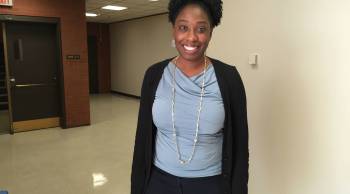Adjunct faculty demonstrate for better conditions
Like many part-time college instructors, Basak Durgun doesn’t have an office. She often meets students or other faculty in the food court on campus.
“My office is my backpack,” she says.
That’s a problem, because Durgun has nowhere to meet privately with students in her Cultural Studies classes. Last semester, she says, serious issues like mental health and plagiarism came up.
“All of these intense moments I had to have right in front of the classroom in public,” she says.
On Wednesday, thousands of adjunct faculty and their students around the country are planning demonstrations to demand better working conditions. More than half of college classes are taught by temporary and part-time instructors, often for low pay and no benefits. Organizers are calling it National Adjunct Walkout Day. Given the precarious nature of the job, it’s not clear how many will actually leave their classrooms.
In Virginia, it’s illegal for public employees to walk off the job. So adjuncts at George Mason are planning a teach-in to talk with students and faculty about their working conditions. In addition to private space, they want to be paid for the time they spend prepping for classes, and a cancellation fee when classes are cut at the last minute.
On the other side of the country, Larry Cushnie and his fellow adjuncts are planning a walkout. Cushnie teaches political science at Seattle University, where he says adjuncts make up more than half of the faculty. Adjuncts there have been fighting to form a union.
Cushnie has a PhD and this year is making $48,000 teaching full-time. Next year, though, he has no idea what and where he’ll be teaching. Nationally, a typical adjunct makes about $2,700 per course.
“What life is like is kind of just scrapping quarter to quarter, year to year, to put together a schedule that will kind of meet your needs of basic income,” he says.
The administration at Seattle University declined to be interviewed. At George Mason, Provost David Wu says the university relies heavily on adjuncts not just to save money. Because it’s close to Washington, D.C., he says, George Mason can take advantage of local talent. Many instructors have other careers at, say, the State Department or Lockheed Martin, he says.
“The vast majority of our faculty are working professionals,” Wu says. “A relatively small percentage of them are actually doing adjunct teaching as their primary occupation.”
Career adjuncts make up a growing share of the faculty on campuses, though, many of which charge students $50,000 a year. According to the American Association of University Professors, more than three-quarters of instructors are not on the tenure track. If all of them were to walk out today, activists say colleges would grind to a halt.
CORRECTION: An earlier version of this story misspelled David Wu’s name. The text has been corrected.
There’s a lot happening in the world. Through it all, Marketplace is here for you.
You rely on Marketplace to break down the world’s events and tell you how it affects you in a fact-based, approachable way. We rely on your financial support to keep making that possible.
Your donation today powers the independent journalism that you rely on. For just $5/month, you can help sustain Marketplace so we can keep reporting on the things that matter to you.


















